Fossil (Biodiversity)
Contents
Fossil
| Topics: |
Geology (main)
|
 Trilobite Olenoides erratus. Source: Mark A.Wilson A fossil is the preserved remain of a lifeform that lived in prehistoric times. Most commonly fossils are mineralized parts or a whole organism which is no longer alive. In other cases the fossil may contain actual remains of the dead organism; in particular, DNA may be preserved over long periods of time under the right conditions, since DNA is fundamentally an inanimate molecule. While the most familiar fossils are those derived from animals and plants including such exotic species as dinosaurs and woolly mammoths, there are also fossils from ancient bacteria.
Trilobite Olenoides erratus. Source: Mark A.Wilson A fossil is the preserved remain of a lifeform that lived in prehistoric times. Most commonly fossils are mineralized parts or a whole organism which is no longer alive. In other cases the fossil may contain actual remains of the dead organism; in particular, DNA may be preserved over long periods of time under the right conditions, since DNA is fundamentally an inanimate molecule. While the most familiar fossils are those derived from animals and plants including such exotic species as dinosaurs and woolly mammoths, there are also fossils from ancient bacteria.
There are several methods of fossil formation including re-crystallization, permineralization, compression, molding and entombment. Examination of fossils was the earliest technique of palaeoentology, the study of ancient lifeforms, and it continues as the companion of molecular biology, to be key in the elucidation of phylogenies (ancestral relationships of species). The earliest animal fossils date from the Cambrian Period, approximately 540 million years before present, although some bacterial fossils exist from at least two billion years before present.
Process of formation
Most fossils are the result of sedimentary rock formation where coverage of the original organism occurred quickly; preservation and mineralization is encouraged by anoxic (oxygen deprived) conditions, where decompostion was not able to occur rapidly upon death of the subject. Body parts most readily preserved are teeth and bony animal parts and the chitonous elements of plants, which elements are most resistive to decay, and thus have more time to enter their preserved state.
Recrystalization
 Recrystallized Scleractinian fossil coral. Source: Mark A.Wilson
Recrystallized Scleractinian fossil coral. Source: Mark A.Wilson
One of the simplest processes for fossil formation is the phenomenon of re-crystalization. This is an easily understood process, whereby substances such as teeth and bone, which begin with a high mineral content, have their chemicals replaced by a new crystalline lattice. In a number of instances, mineral replacement of the original body part transpires so gradually that microstructural features are conserved even though a complete transformation of the original organism's material occurs. A shell is termed recrystallized when the original skeletal compounds are still present but in a different crystal form, as in a transition form aragonite to calcite. The process of re-crystallization is often termed replacement.
Permineralization
Living organisms ordinarily contain large amounts of volume that is filled with water or gases. When an organism is covered with sediment, those aqueous and gaseous portions of the individual may be replaced with mineral rich water from an aquifer or surface water body. This process is termed permineralization, and often is best viewed as a replacement phenomenon at the cellular level. Fine grained or small scale permineralization produces very detailed fossil specimens. For permineralization to occur, it is essential for the organism to become covered by sediment rapidly upon death, before significant decay has set in. In ideal cases of preservation, individual cell walls can be effectively fossilized, producing an incredible level of microscopic preservation.
Compression
Compression fossils, most often exemplified by planar plant forms such as leaves or ferns, result from chemical reduction of complex organic molecules that comprise biotic tissues. The fossil actually preserves originalorganism material, but in a geochemically altered state. In many cases the preserved fossil is nothing but a thin carbonaceous film.
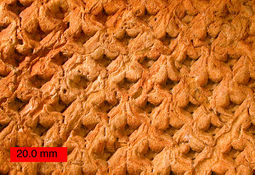 Lepidodendron external mold. Source: Mark A.Wilson
Lepidodendron external mold. Source: Mark A.Wilson
Such a chemical change is a manifestation of diagenesis, the transformation of sediment after its original deposition. In some cases DNA may effectively be extracted from compression fossils.
Internal or external mold
In some cases the entire organism may vanish, but an exterior mold will be made by sedimentary rock encasing the original remains of the organism which has been completely dissolved or destroyed. This casting results in a sculptured cavity within the rock, with the exterior three dimensional outline of the original organism's exterior; the product of this process is termed an external mold. If this hole is subsequently filled with different minerals, it is a cast and called an internal mold. A common example of this latter type of mold is a bivalve mollusc.
Entombment
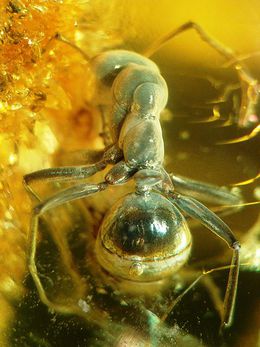 Ant entombed in Baltic Amber. Souce: Anders L.Damgaard
Ant entombed in Baltic Amber. Souce: Anders L.Damgaard
In some cases exceptional preservation may occur by a relatively rapid fatal trapping and encasing of a live organism with (usually) an organic substance such as amber or tar. Some of these circumstances create fossils of unusual life-pose forms, and many of these instances provide substantial detail of the subjects. For example, recent research using crystallography has yielded amazing structural detail of the morphology of long extinct insects that were trapped in amber.
Bioimmuration
Bioimmuration is a form of fossilization whereby a skeletal organism envelopes orsubsumes another living creature, preserving the latter, or its mold, within the skeleton. Most typically this process occurs with a sessile skeletal animal, such as a bryozoan or an oyster, which grows along a substrate that covers other sessile encrusting organisms. Frequently the bioimmured organism is soft-bodied and is thus conserved in negative relief in an external mold form. There are also cases where an organism settles on top of a living skeletal organism which grows upwards, preserving the settler within its skeleton. Most of the examples of bioimmuration are from the fossil record of the Ordovician Period.
Fossil record
The geological record and fossil records are respectively the prehistoric sequence of events for rocks and organisms. In the 19th century early days of research in these fields age of rocks was imputed from the best estimates of the age of the fossil organisms found entrained within those rocks.
The fossil record and flora and faunal succession form the basis of biostratigraphy, the science of determining the age of rocks based on the fossils they contain. For the earliest years of geological study, biostratigraphy and superposition were the chief methods of assigning the relative age of rocks. The geologic time scale was first developed based on the relative ages of rock strata as determined by pioneering paleontologists.
Since the early 1900s, absolute dating methods, including radiometric dating (including potassium-argon argon/argon and uranium-lead dating techniques were applied. In the case of young fossils, carbon-14 dating has been applied to verify the relative ages obtained by fossils and to provide absolute ages for many fossils. Radiometric dating has shown that the earliest known stromatolites, or bacterial fossils, are more than 3.4 billion years old.
Since the close of the 20th century new techniques in molcular biollogy using DNA marker techniques have allowed great progress to be made in defining phylogenetic trees, which illustrate the lineage of plant and animal families. These techniques can also use regression techniques to establish reasonable estimates of the absolute timelines of common parentage of biotic families.
Earliest fossils
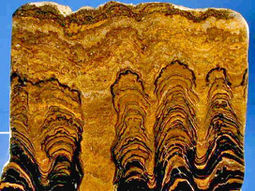 Proterozoic stromatolite cyanobacteria fossil, Bolivia. Source: GNU SNP
Proterozoic stromatolite cyanobacteria fossil, Bolivia. Source: GNU SNP
The most ancient fossils are bacterial colonies constructed from sedimentary layers of rock; these fossils are termed stromatolite. Based on studies of living stromatolites it has been ascertained that the formation of stromatolitic fossils was biogenetically mediated by microorganism mats via sediment entrapment. However, abiotic mechanisms for stromatolitic growth are also known, leading to a decades-long scientific debate regarding biogenesis of certain formations, especially those from the lower to middle Archaean eon.
Stromatolites from the late Archaean through the middle Proterozoic eon were chiefly formed by massive colonies of cyanobacteria, and that the oxygen byproduct of their photosynthetic metabolism first resulted in earth’s massive banded iron formations and subsequently oxygenated Earth’s atmosphere.
History of fossil studies
 Georges Cuvier, French zoologist (1769-1832)
Georges Cuvier, French zoologist (1769-1832)
The Greek scientist Aristotle observed that fossilized shells were previously living organisms, constituting the first observational recognition of the relationship of a time relationship between earlier living organisms and their fossilized remnants. In the pre-Darwinian era of the 18th century English geologist William Smith noticed that rocks of varying ages and origins preserved different fossil assemblages, which succeeded in a systematic sequence. He was the first to state that rocks from distant locations may be correlated based on the fossils they contained, and he termed this the principle of faunal succession.
Smith expressed no awareness of biological evolution, and he did not speculate why faunal succession occurred. His contemporary Lord Monboddo, in nearby Scotland, was expressing a clear recognition of evolutionary sequences, but the two are not known to have communicated. Biological evolution would later explains faunal and floral succession exists: as different organisms evolve, change and go extinct, they leave behind fossils. Faunal succession was one of the chief pieces of evidence cited by Darwin that natural selection had occurred. Georges Cuvier in 1796 noted that the majority of the animal fossils he examined were remains of species that had become extinct. It was not until the era of Charles Darwin and his contemporaries that a clearly stated link existed with the hierarchical tree of life and the fossil record.
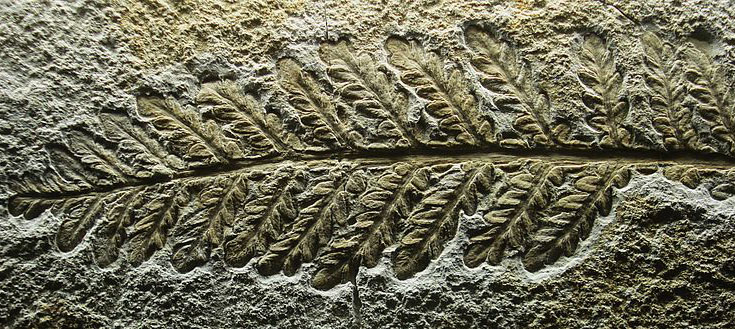 Image by Ghedoghedo (Wikimedia Commons)
Image by Ghedoghedo (Wikimedia Commons)
References
Process of formation
- T.P.Jones and Nick P.Rowe. 1999. Fossil plants and spores: modern techniques. Geological Society. 396 pages
- Berndt Herrmann and Suzanne Hummel. 1994. Ancient DNA: recovery and analysis of genetic material from paleontological, archaeological, museum, medical, and forensic specimens. Springer. 263 pages
- Paul Selden and John R. Nudds. 2004. Evolution of fossil ecosystems. Manson Publishing. 160 pages
Fossil record
- Douglas H.Erwin and Robert L.Ansley. 1995. New approaches to speciation in the fossil record. Columbia University Press. 342 pages.
- Eduardo A.M.Koutsoukos. 2007. Applied Stratigraphy. Springer. 488 pages
History of fossil studies
- William Knight. 1900. Lord Monboddo. John Murray. London. 314 pages
- Charles Darwin. 1859. On the Origin of Species. Chapter 10: On the Imperfection of the Geological Record.
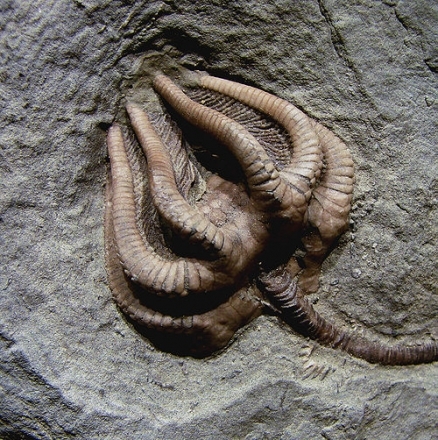
1 Comment
gina castro wrote: 02-23-2013 19:56:37
cool